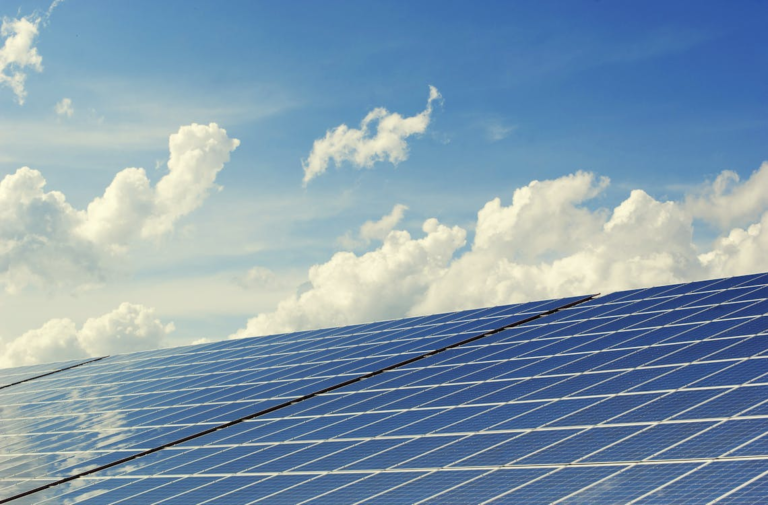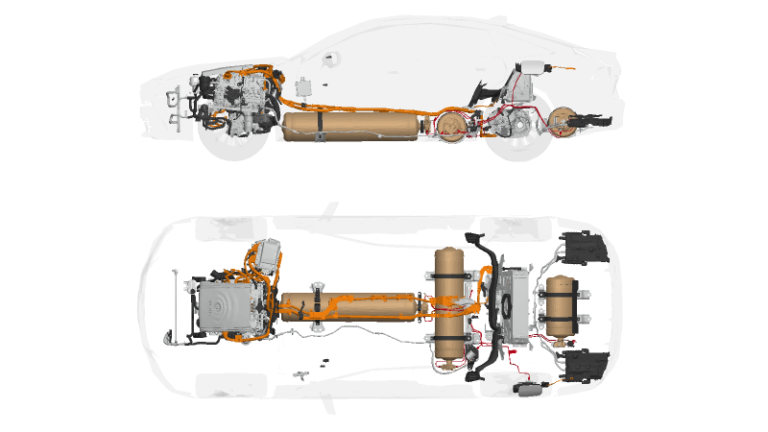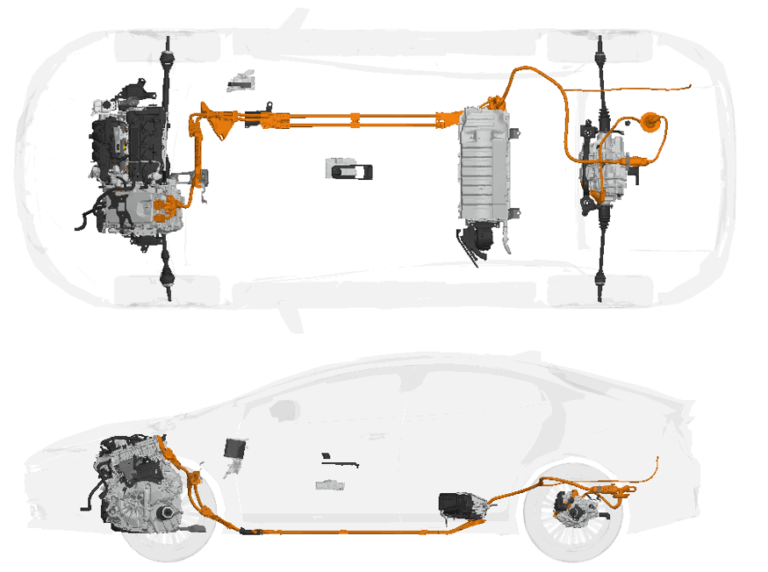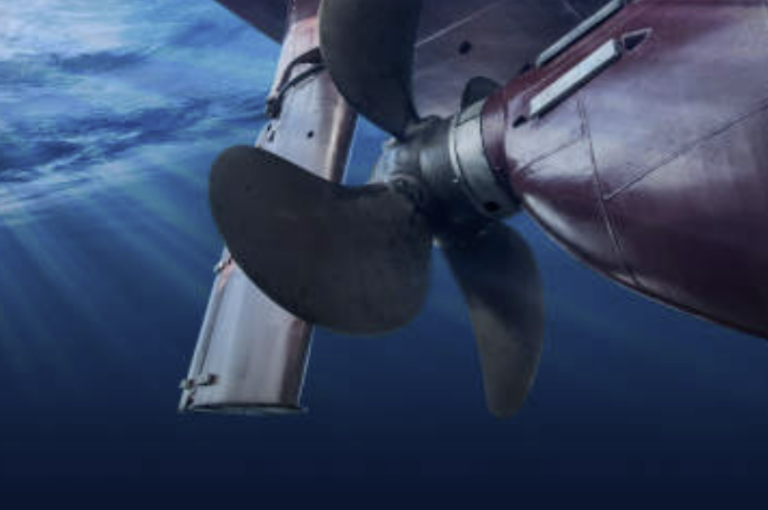The Need for Electrified Vehicles
In the ever-evolving landscape of transportation, the need for electrified vehicles has become increasingly apparent. This shift is not just a trend but a critical step towards a sustainable and decarbonized future. In recent years, there has been a growing interest in electrified powertrain systems for both personal and commercial vehicles. These systems encompass the key components responsible for generating and delivering power to the road surface, catering to applications in fully electric, hybrid electric, and plug-in hybrid electric vehicles.

Electrified vehicles (EVs), hybrid electric vehicles (HEVs), and plug-in hybrid electric vehicles (PHEVs) bring several advantages, including reduced emissions, enhanced fuel efficiency, and heightened low-end torque. However, they are not without their share of technical challenges. Let’s explore the multifaceted aspects of electrified powertrains, ranging from their impact on decarbonizing the transportation sector to the intricacies of battery materials and the global surge in electrified vehicle (EVs) adoption.
Decarbonizing the Transportation Sector: A Prerequisite for a Greener Tomorrow
Automakers and governments are actively promoting electrified powertrains in the transportation sector for several compelling reasons:
1) Energy Diversity: Embracing electrified powertrains allows for greater energy diversity. By shifting from conventional fossil fuels to electricity, the transportation sector can tap into a wider range of energy sources, including renewables like solar, wind, and hydropower. This diversification helps reduce dependency on a single energy resource, enhancing overall energy resilience.
2) Energy Security: Governments recognize the importance of energy security. Electrified powertrains contribute to this by leveraging domestically produced electricity, and reducing reliance on imported oil. This enhances a country’s energy independence and shields it from geopolitical uncertainties affecting traditional energy sources.
3) Potentially Lower Emissions: One of the primary motivations for transitioning to electrified powertrains is the potential to lower emissions. Electric vehicles (EVs) produce little to no tailpipe emissions, significantly improving local air quality. As the electricity grid becomes greener with increased use of renewables, the overall carbon footprint of EVs decreases, making them an environmentally friendly alternative to conventional vehicles.
4) Potentially Reduced Carbon Footprint: The push for electrified powertrains aligns with global efforts to mitigate climate change. By transitioning to electric vehicles and promoting renewable energy sources, both governments and automakers aim to reduce the carbon footprint associated with transportation. This transition is crucial in meeting international climate goals and addressing environmental concerns associated with traditional combustion engine vehicles.
A Sustainable Drive: Electrified vehicles Leading the Charge in Decarbonizing Transportation
The transportation sector has long been a major contributor to greenhouse gas (GHG) emissions, primarily through the combustion of fossil fuels. The transportation sector is responsible for more than 29% of greenhouse gas (GHG) emissions and over 55% of total NOx emissions in the U.S. To mitigate climate change and reduce our carbon footprint, a paradigm shift is imperative. Electrified powertrains, such as those found in EVs and hybrid electric vehicles (HEVs), play a pivotal role in this transition by minimizing or eliminating tailpipe emissions.
US DOE VTO’s Mission: Decarbonize transportation across all modes:
- Net zero by 2050 requires dramatic energy efficiency and emissions improvements in vehicles and the overall transportation system
- 100% clean electricity and dramatic technology cost reductions enable deep transportation decarbonization
- On-road vehicles (Light, Medium, Heavy) account for 83% of energy use and can be electrified by leveraging cheap and abundant clean electricity
- Long Haul freight movement and Air, Marine, and Rail (locomotive) will likely require Hydrogen and Biofuels to meet this target
GHG Mitigation Potential: Crunching the Numbers
The potential for mitigating GHG emissions through electrified vehicles is substantial. Electric vehicles, in particular, produce zero tailpipe emissions, significantly reducing air pollution and mitigating the impact of climate change. The shift to electric mobility is a crucial component of global efforts to achieve ambitious emission reduction targets. EVs are the single most important technology for decarbonizing the transportation sector.
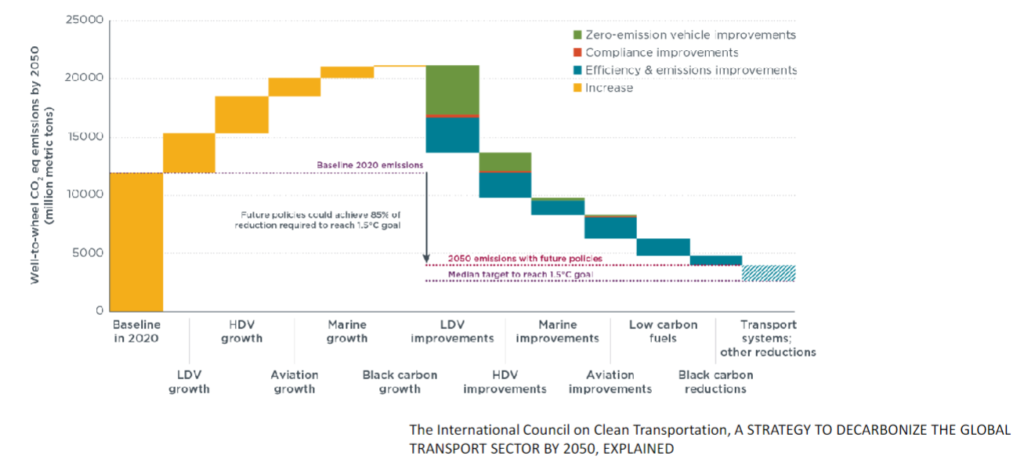
Global Trend of Electrified Vehicles: From Niche to Mainstream
In recent years, the global automotive landscape has witnessed a seismic shift towards vehicle electrification. Governments, manufacturers, and consumers alike are recognizing the environmental and economic benefits of electrified powertrains. Major automakers are investing heavily in electric vehicle development, signaling the industry’s commitment to a cleaner, more sustainable future.
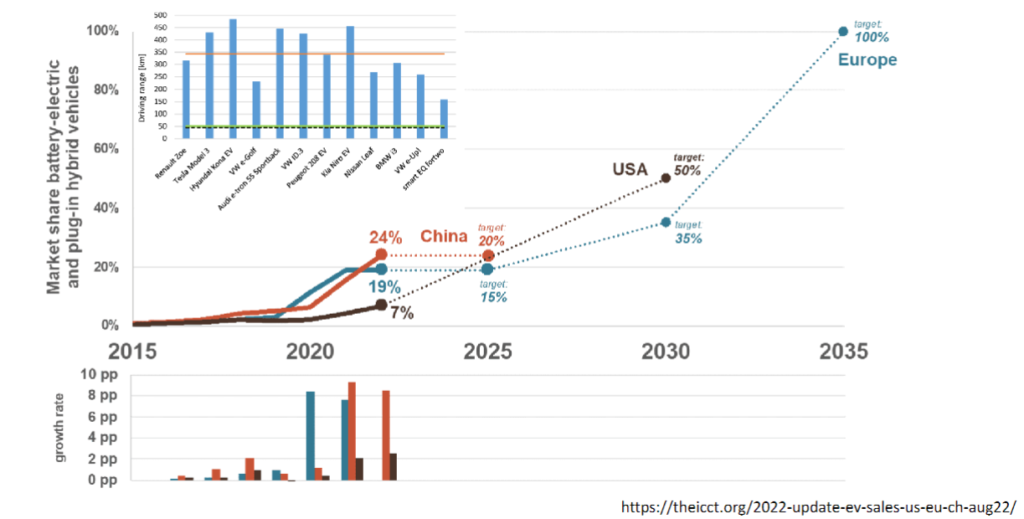
China has set targets that, by 2023, all vehicles sold need to be electrified. Europe, on the other hand, has completely banned the sale of ICE by 2023. The US Government has already declared that by 2040, its government fleet will have 100% replaced any of its ICE vehicles with BEVs. This is leading automakers to face two options: either heavily invest in BEVs or pull out of certain markets altogether.
Material Cost Trend of Batteries: The Heart of Electrified Vehicles
While the demand for EVs is escalating, the cost of batteries remains a critical factor influencing their widespread adoption. Technological advancements and economies of scale are gradually driving down battery costs, making electric vehicles more accessible to a broader audience. Understanding the material cost trend is essential for predicting the trajectory of EV affordability.

Even though the raw material cost per vehicle of BEVs has begun to come down, the overall cost is still about twice that of ICE vehicles. Making all BEVs still more expensive than ICE alternatives, customers need a more cost-effective option. The US Government has begun to tackle this problem by passing the Inflation Reduction Act, which states that beginning in January 2024, dealers can provide customers with the tax credit as a rebate at the time of purchase, making EVs more affordable.
xEV Sales in the US Market: Accelerating Adoption
The United States, a key player in the automotive industry, has experienced a surge in xEV (collective term for electrified vehicles) sales. This shift is driven by factors such as government incentives, increased consumer awareness, and a growing charging infrastructure. Examining the sales trends provides valuable insights into the evolving preferences of American consumers and the industry’s response. During the COVID years the US experianced a huge boom in BEV sales, however as of 2021 the most popular electrified vehicle is a HEV. This customer demand is fueling all automakers to invest heavily in vehicle eletrification.

Cost of Avoided GHGs: Investing in a Sustainable Future
Beyond the initial investment in electrified powertrains, it’s crucial to evaluate the long-term benefits in terms of avoided GHG emissions. The cost of avoided emissions becomes a compelling metric, showcasing the economic value of transitioning to electric vehicles and encouraging further investment in sustainable transportation solutions.
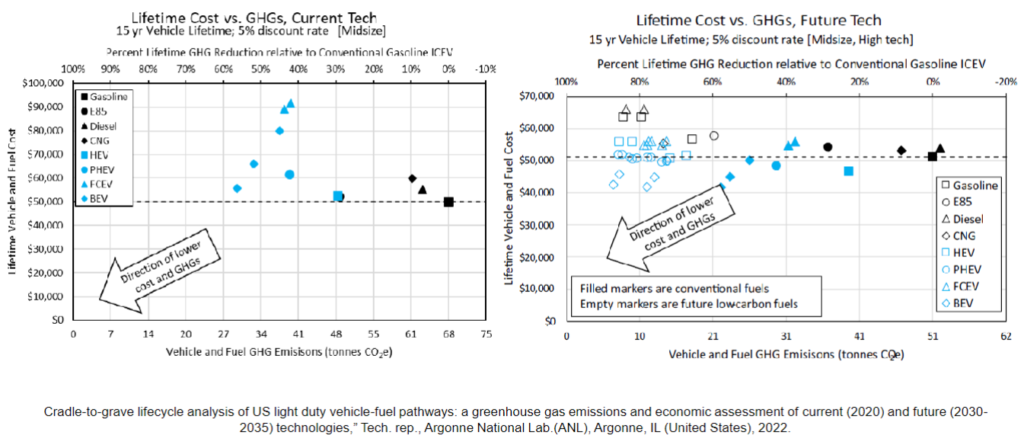
Connecting the Two Energy Sectors: Synergy in Electrified Vehicles
The convergence of the transportation and energy sectors is a key aspect of electrified powertrains. As electric vehicles become more prevalent, the demand for clean and renewable energy sources intensifies. This synergy highlights the interconnectedness of these sectors and underscores the importance of developing sustainable energy solutions to power the growing fleet of electric vehicles. When designing a vehicle’s powertrain automakers need to ask themseleves what are the desirable properties?
- High energy density – Long range
- High power density – Fast acceleration
- Simple and fast refueling
- Low environmental impact (health aspects)
- Infrastructure
Depending on the type of vehicle and its target audience automakers can mix and match where the vehicle gets its power from to enable them to design a vehicle with the desired properties.

Pathway of Vehicle Electrification: From Conventional to Electrified
Understanding the pathway of vehicle electrification involves considering the diverse types of electric vehicles available. Drivetrain hybridization has been adopted at different levels, ranging from stop-start and mild hybrids to strong hybrids and plug-in hybrid electric vehicles, each exhibiting escalating degrees of electrification. The diverse hybrid architectures, the technologies employed for their implementation are elaborated below.
The six levels of vehicle electrification
A possible classification of today’s vehicles in the market can be given based on internal combustion engine size and electric machine size.
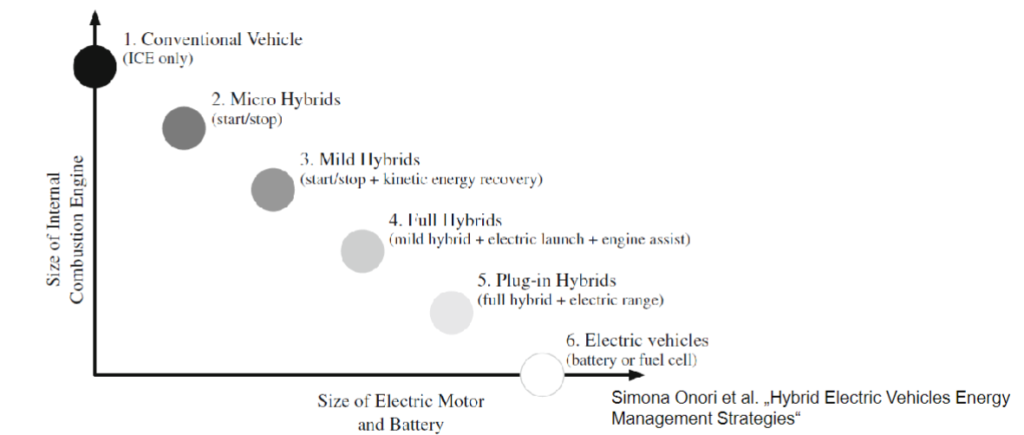
Level 1 – Conventional Vehicle (ICE only): This represents the traditional Internal Combustion Engine (ICE) vehicle, relying solely on gasoline or diesel for propulsion, with no electric components.
Level 2 – Micro Hybrid (Start/Stop only): Micro Hybrids introduce a basic electric feature: automatic engine start/stop functionality. The engine shuts down when the vehicle is stationary and restarts when the driver accelerates, improving fuel efficiency.
Level 3 – Mild Hybrid (Start/Stop & Kinetic Energy Recovery): Mild Hybrids incorporate kinetic energy recovery during braking, converting it into electric energy. This stored energy assists the engine during acceleration, enhancing fuel efficiency and reducing emissions.
Level 4 – Full Hybrid: Full Hybrids operate on both internal combustion and electric power, seamlessly switching between the two. The electric motor assists the engine, and the vehicle can run on electric power alone at low speeds.
Level 5 – Plug-in Hybrid Vehicle (PHEV): PHEVs can operate on electric power alone for a significant range, thanks to a larger battery that can be charged externally. They offer the flexibility of using electricity or an internal combustion engine, ideal for short trips and longer journeys.
Level 6 – Electric Vehicle (BEV/EV): BEVs exclusively rely on electric power for propulsion, with no internal combustion engine. They are charged externally and produce zero tailpipe emissions, contributing to a cleaner and sustainable transportation future.
These levels reflect the evolving landscape of vehicle electrification, providing consumers with a range of options based on their preferences, driving habits, and environmental considerations.
The electric vehicle market is no longer limited to a single type. Battery electric vehicle (BEV), Plug-in Hybrid electric vehicle (PHEV), Hybrid electric vehicle (HEV) and Fuel Cell electric vehicle (FCEV) all cater to different driving profiles and use cases. Delving into the specifics of each type equips consumers with the knowledge needed to choose the electric vehicle that best aligns with their lifestyle and environmental goals.

Sample Problem:
Do a literature search about currently commercially available recent electrified vehicles (HEVs,
PHEVs, and BEVs). Summarize data in a table by EV type. The following information should be
included:
- Type of hybridization: parallel, series, power-split fuel economy label (MPGe)
- The battery pack size in terms of capacity (Ah) and energy (kWh)
- Cooling type of the battery pack for each vehicle: is it liquid- or air-cooling?
- The sources of the information
Sample problem answer
To have a better comparison I compared hybrid, PHEV, and BEVs separately. Finally, I also focused on a specific vehicle segment to better contrast between different vehicles. For BEVs, I focused primarily on the 4-door sport sedan segment while when comparing hybrid vehicles, I focused on the mid-size compact SUV segment. Unfortunately, I was not able to find 4 vehicles in a single segment for PHEVs. So, I decided to choose larger mid-size SUVs to benchmark. Two of the SUVs are more mainstream such as the KIA and Mitsubishi. The last two SUVs occupy more of the premium SUV segment, Jeep and Volvo.
Please see the 3 charts below. The number on the top right corner of each cell is to indicate where the information came from.
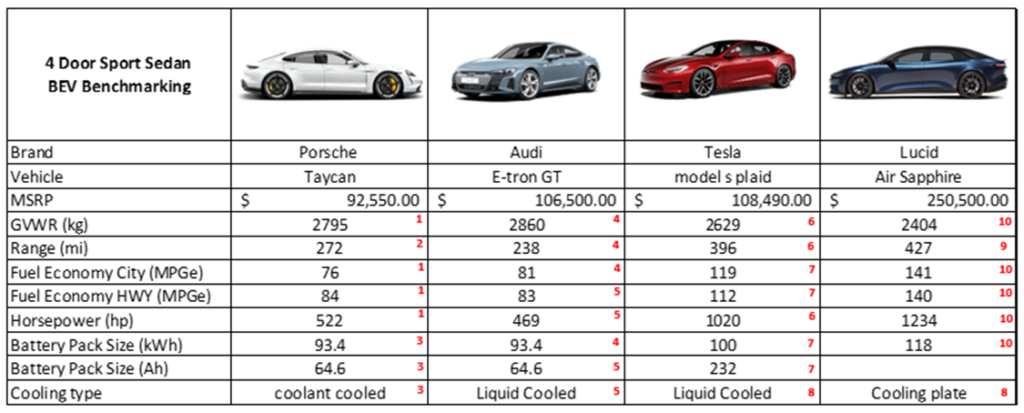
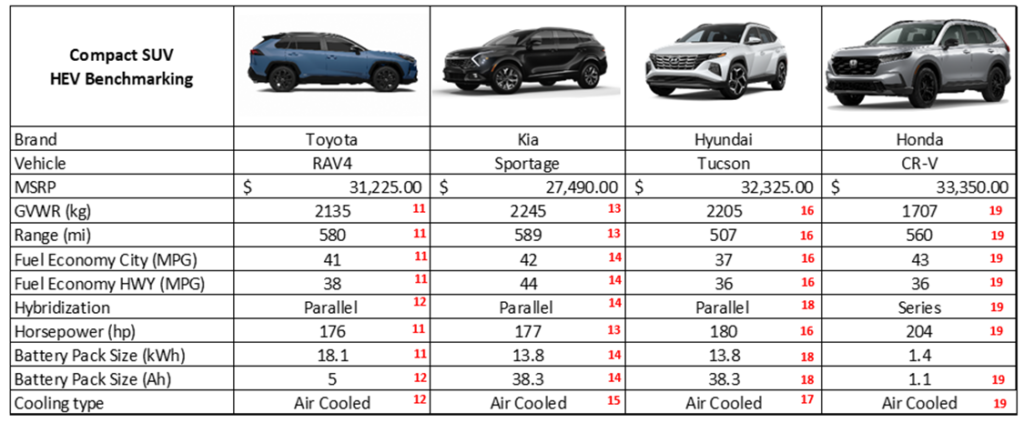
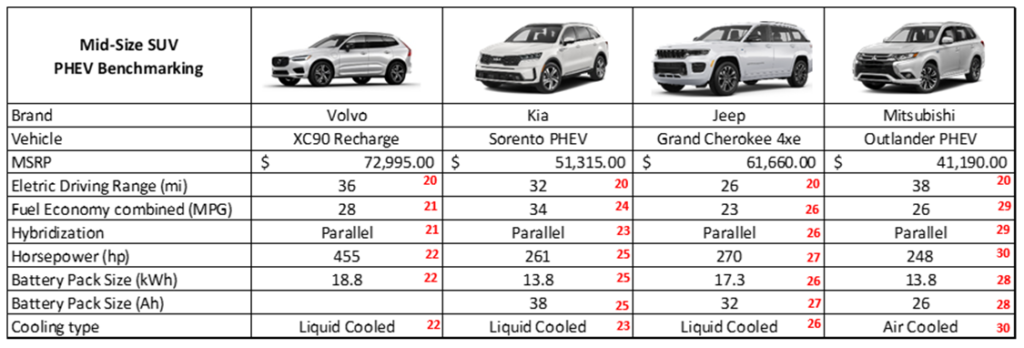
HEV Configurations: Striking the Right Balance
HEVs exclusively utilize gasoline for their energy needs. However, in comparison to traditional vehicles, they employ this fuel more efficiently for vehicle propulsion. Typically, hybrid vehicles incorporate an internal combustion engine, a battery, and one or more electrical machines. It’s worth noting that one of the earlier hybrid models featured a Stirling engine. HEVs achieve fuel consumption reduction relative to conventional vehicles through three primary methods: the incorporation of regenerative braking, minimizing idle time, and enabling engine downsizing.

HEVs represent a bridge between conventional and fully electric vehicles. Understanding the different HEV configurations, such as series and parallel hybrids, provides insights into how these vehicles optimize fuel efficiency and reduce emissions. HEVs play a crucial role in the transition to electrified powertrains, offering a flexible and practical solution for a variety of driving scenarios.
What are the different configurations of HEV?
HEVs can be categorized into four groups based on their mechanical/electrical architectures: parallel hybrids, series hybrids, axle-split hybrids, and power-split hybrids.

The two most common types of configurations are parallel and series hybrids. In a series hybrid, the internal combustion engine (ICE) solely charges the battery, which then powers an electric motor driving the wheels. Parallel hybrids, on the other hand, enable both the ICE and electric motor to directly propel the vehicle, either independently or simultaneously. Additionally, there are blended configurations that combine elements of both series and parallel setups. Each configuration aims to optimize fuel efficiency and emissions in different driving scenarios, offering consumers a range of options to suit their preferences and driving needs.
Conclusion
In conclusion, the need for electrified vehicles transcends mere technological advancement. It embodies a collective commitment to mitigating climate change, reducing pollution, and securing a sustainable future for generations to come. As the global automotive landscape continues to evolve, embracing electrified powertrains is not just an option—it’s an imperative step towards a greener and more sustainable tomorrow.
Reference
National Academies of Sciences, Engineering, and Medicine. 2015. “Cost, Effectiveness, and Deployment of Fuel Economy Technologies for Light-Duty Vehicles.” Washington, DC: The National Academies Press. https://doi.org/10.17226/21744.
